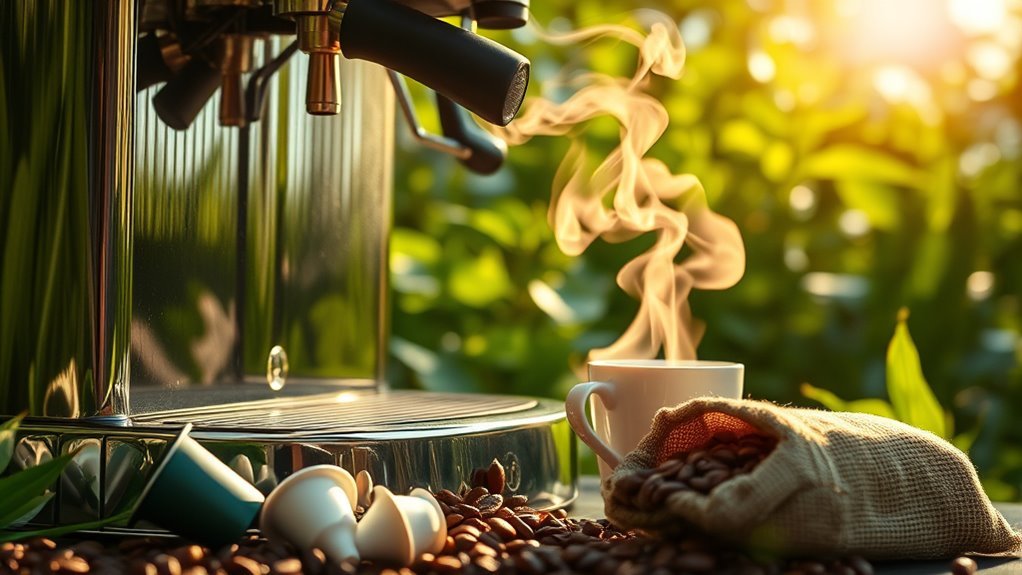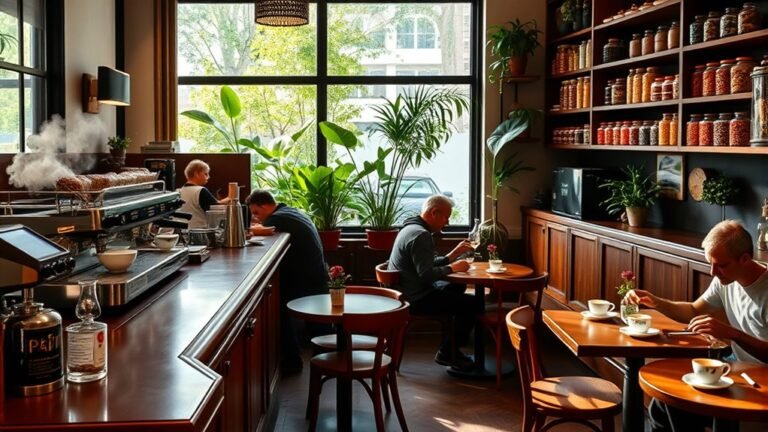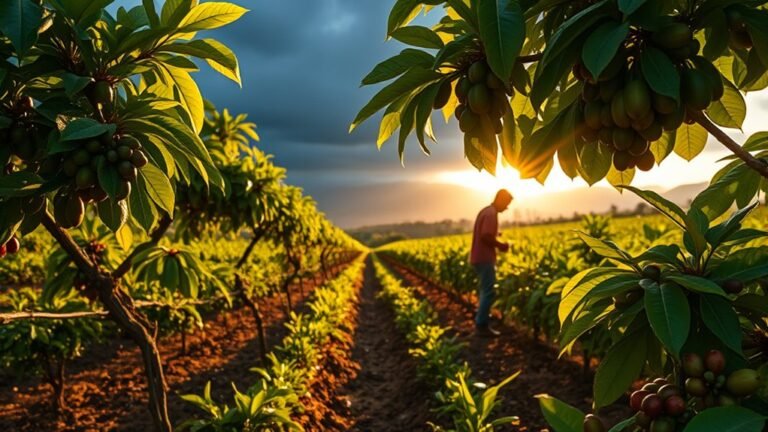The Environmental Impact of Coffee Equipment
The environmental impact of coffee equipment is quite significant. You’ll find that energy-efficient machines can cut energy use by up to 30%, while single-use products lead to extensive landfill waste. Additionally, water usage varies greatly depending on your brewing method. Investing in durable and recyclable equipment helps minimize waste and promotes sustainability. By making informed choices in your coffee preparation, you can influence both your carbon footprint and the longevity of your equipment. Discover more about these practices.
Energy Consumption of Coffee Equipment
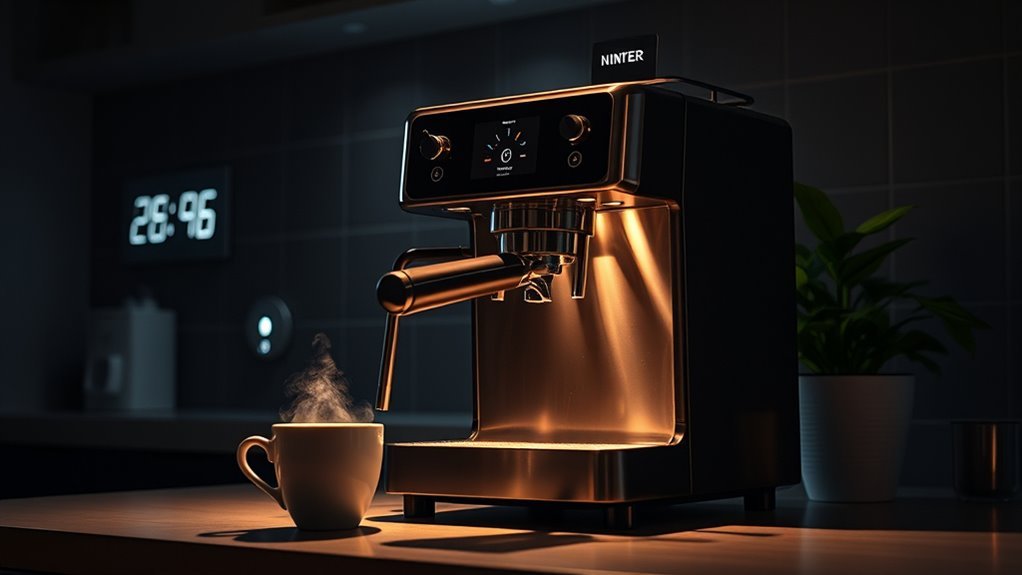
When you consider the energy consumption of coffee equipment, it becomes clear that the type of machine you choose can considerably impact its environmental footprint. Energy efficiency is essential; machines designed with advanced technology often consume less power while maintaining performance. For instance, high-efficiency espresso machines can reduce energy use by up to 30% compared to older models. Additionally, equipment longevity plays an important role in minimizing energy consumption over time. Investing in durable machines means fewer replacements, which can lead to reduced energy and resource use during production and disposal. By prioritizing energy-efficient designs and long-lasting equipment, you can enjoy your coffee while contributing to a more sustainable future and exercising your freedom to make environmentally conscious choices.
Material Waste From Coffee Brewing Tools
When you consider the material waste generated by coffee brewing tools, the choice between single-use accessories and more durable options becomes essential. Research shows that single-use items contribute greatly to waste, impacting both landfills and recycling systems. By opting for reusable materials, you can mitigate this environmental burden while enjoying your coffee.
Single-Use Accessories Impact
Although the convenience of single-use accessories in coffee brewing, such as paper filters and disposable cups, may seem appealing, their environmental impact cannot be overlooked. Research indicates that millions of single-use cups are discarded daily, contributing greatly to landfill waste. These disposable filters, often made from bleached paper, add to this problem, as they decompose slowly and can leach harmful chemicals into the soil. Additionally, the production of these items consumes valuable resources, including water and energy, exacerbating their ecological footprint. If you value freedom, consider the freedoms of future generations by minimizing waste. Shifting to reusable alternatives not only reduces material waste but also supports a more sustainable coffee culture. Every small change counts toward a healthier planet.
Durable vs. Disposable Materials
While many coffee enthusiasts seek convenience in their brewing methods, the choice between durable and disposable materials greatly affects material waste. Opting for durable options not only reduces waste but also aligns with sustainable practices. Here are some key considerations:
- Biodegradable alternatives can minimize landfill contributions but still require resources to produce.
- Reusable containers considerably cut down on single-use plastics, promoting a circular economy.
- Long-lasting equipment often provides better performance and flavor consistency, enhancing your brewing experience.
- Choosing sustainable materials can foster a sense of responsibility and connection to the environment.
The Role of Single-Serve Pods in Environmental Degradation
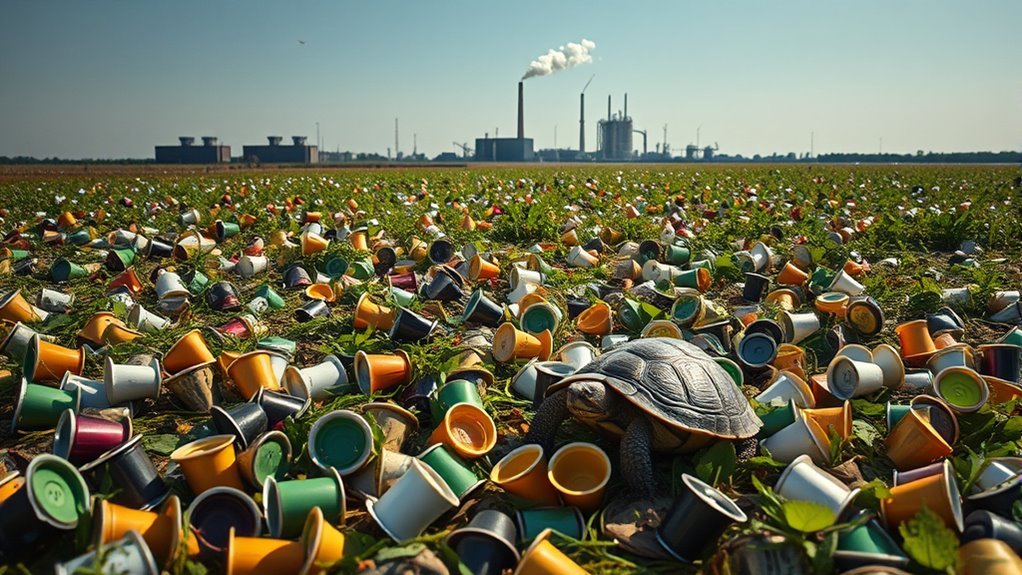
As coffee consumption continues to rise globally, the convenience of single-serve pods has made them a popular choice among consumers. However, their environmental impact cannot be ignored. Many pods aren’t recyclable, leading to significant landfill waste. While some companies are investing in pod recycling programs and material innovation, the uptake remains low.
| Aspect | Impact |
|---|---|
| Pod Recycling Rate | Less than 10% |
| Carbon Footprint | High compared to ground coffee |
| Material Innovation | Limited options available |
You might be surprised to learn that the convenience you enjoy comes at a cost to the planet. It’s essential to evaluate alternatives that align with your values while enjoying your coffee ritual.
Water Usage in Coffee Preparation
The convenience of single-serve coffee pods raises questions not only about waste but also about the resources required for brewing coffee, particularly water usage. Many consumers overlook how preparation techniques impact water conservation. Understanding this can empower you to make more sustainable choices.
Single-serve coffee pods may be convenient, but they often consume more water than traditional brewing methods.
- Single-serve pods typically require more water per cup than traditional brewing methods.
- Drip coffee makers can optimize water usage by brewing larger quantities.
- Manual methods, like pour-over, allow for control over water flow and temperature.
- Investing in efficient equipment can greatly reduce overall water consumption.
The Carbon Footprint of Coffee Machines
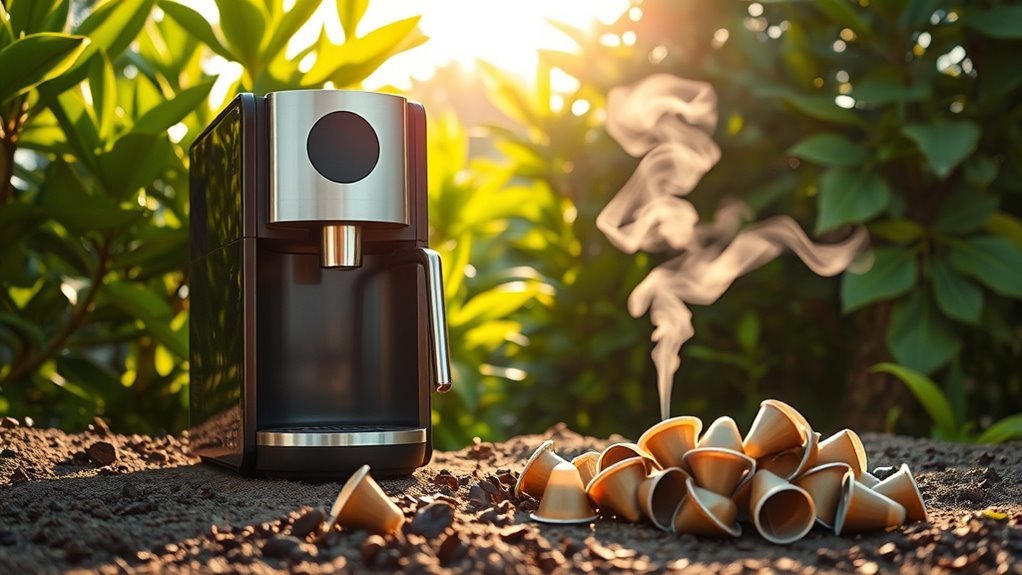
Although coffee machines are essential for brewing your daily cup, their carbon footprint can be significant, contributing to greenhouse gas emissions throughout their lifecycle. From production to disposal, every phase impacts the environment. For instance, manufacturing processes consume energy and raw materials, resulting in substantial emissions. To mitigate this, you can adopt emissions reduction strategies, like choosing energy-efficient models or maintaining your machine to enhance its longevity. Additionally, consider the end-of-life stage; recycling parts can minimize waste and emissions. By being mindful of the coffee machine lifecycle, you empower yourself to make choices that align with your values of sustainability and freedom. Every small action can lead to a collective effort in reducing our carbon footprint.
Sustainable Materials for Coffee Equipment
While many coffee enthusiasts appreciate the quality of their brew, it’s crucial to recognize how the materials used in coffee equipment can greatly impact environmental sustainability. Utilizing sustainable materials not only reduces waste but also promotes a healthier planet. Here are some options to reflect on:
- Biodegradable materials: These break down naturally, minimizing long-term environmental impact.
- Recycled plastics: Using plastics that have been repurposed limits the need for virgin materials and reduces landfill waste.
- Wood alternatives: Sustainably sourced woods can offer durability without contributing to deforestation.
- Glass components: Glass is recyclable and doesn’t leach harmful chemicals, making it a safer choice for both health and the environment.
Choosing these materials can empower you to enjoy your coffee while supporting a sustainable future.
Eco-Friendly Brewing Methods

When considering eco-friendly brewing methods, you should evaluate both the materials used and the energy efficiency of your equipment. Research indicates that using sustainably sourced materials can considerably reduce the environmental footprint of your coffee-making process. Additionally, opting for energy-efficient brewing techniques not only conserves resources but can also lead to cost savings over time.
Sustainable Materials Usage
As consumers increasingly prioritize sustainability, the coffee industry is responding by adopting eco-friendly brewing methods that emphasize sustainable materials. By using materials that reduce environmental impact, you can enjoy your coffee guilt-free.
Consider these innovative options:
- Recycled plastics: Many coffee makers now feature components made from recycled plastics, minimizing waste.
- Bamboo alternatives: Bamboo is renewable and biodegradable, making it an excellent choice for filters and utensils.
- Compostable coffee pods: These pods break down naturally, reducing landfill contributions.
- Glass and stainless steel: Durable and recyclable, they offer a sustainable alternative to single-use items.
Energy Efficient Brewing
The shift towards sustainable materials in coffee equipment naturally leads to a focus on energy-efficient brewing methods, which can greatly reduce the carbon footprint of your daily coffee ritual. By adopting energy-saving techniques, like using a French press or an Aeropress, you can minimize electricity usage while still enjoying a quality cup. Research shows that traditional drip machines consume more energy than eco-conscious brewing alternatives. Additionally, optimizing water temperature and brew time can enhance extraction efficiency, further reducing energy waste. It’s crucial to reflect on your brewing choices; every small adjustment can contribute to a larger impact. Embracing these methods not only supports environmental sustainability but also empowers you to enjoy your coffee with a clear conscience.
Recycling and Disposal of Coffee Gear
While many coffee enthusiasts delight in the daily ritual of brewing their favorite beverage, they often overlook the environmental consequences of their coffee gear. It’s essential to reflect on how you’ll manage your equipment once it reaches the end of its life. Opting for recycling programs can greatly reduce waste, while responsible disposal helps minimize your environmental footprint.
- Check local recycling guidelines for coffee equipment.
- Research brands that offer take-back programs.
- Repurpose old gear creatively instead of discarding it.
- Educate others about sustainable practices in coffee culture.
Impact of Coffee Production on Equipment Longevity
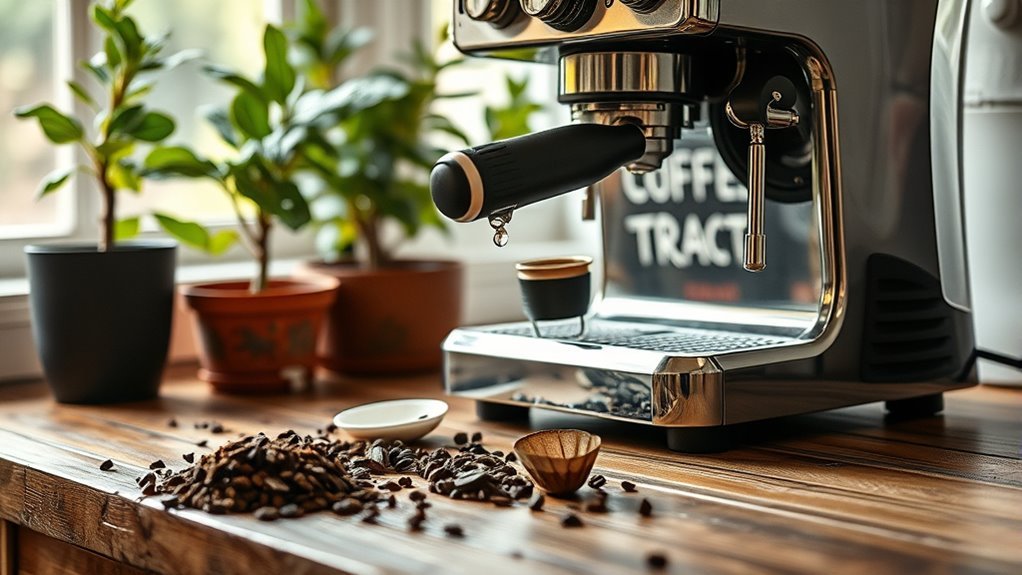
Although you might not immediately connect coffee production with the longevity of your brewing equipment, the two are intricately linked. The durability of coffee equipment often hinges on the production practices behind the beans you choose. For instance, conventional farming methods can lead to lower-quality beans, which might produce more residue and wear on your machinery. In contrast, sustainably grown coffee typically results in cleaner extraction, enhancing your equipment’s lifespan. Research shows that high-quality beans require less maintenance, reducing overall wear and tear. By selecting coffee with responsible production practices, you’re not only supporting the environment but also investing in the durability of your brewing gear. This connection emphasizes the importance of mindful choices in your coffee journey.
The Future of Sustainable Coffee Brewing Solutions
As the demand for eco-friendly practices in every aspect of life grows, coffee brewing solutions are evolving to meet these sustainability challenges. Innovative technologies are paving the way for more sustainable brewing methods, and consumer education is vital for driving this change. You’ll want to stay informed about developments that can help reduce your environmental footprint.
- Energy-efficient machines that minimize electricity usage
- Biodegradable or recyclable materials in brewing equipment
- Water-saving technologies that reduce waste
- Apps and tools that educate consumers on sustainable practices
Frequently Asked Questions
How Does Coffee Equipment Affect Local Ecosystems?
When considering how coffee equipment affects local ecosystems, you’ll find that coffee waste can lead to significant ecosystem disruption. Improper disposal of coffee grounds and filters can introduce pollutants into soil and waterways, harming local flora and fauna. Research shows that these materials can alter nutrient cycles, causing imbalances that affect biodiversity. By understanding these impacts, you can make more informed choices about your coffee habits and their potential effects on the environment.
What Are the Best Practices for Maintaining Coffee Gear Sustainably?
To maintain your coffee gear sustainably, focus on sustainable cleaning methods and energy efficiency. Use eco-friendly detergents that don’t harm the environment and practice regular maintenance to prolong equipment life. Opt for energy-efficient machines that consume less power, reducing your carbon footprint. Regularly descaling and cleaning will guarantee peak performance, minimizing waste and unnecessary replacements. By adopting these practices, you can enjoy your coffee while respecting both your freedom and the planet.
Can Coffee Equipment Be Upcycled or Repurposed Creatively?
Can’t you just imagine the possibilities of upcycling your old coffee equipment? Creative reuse can transform discarded items into functional art or innovative designs for your home. For instance, an old coffee grinder can become a unique planter, while espresso machines can be repurposed into quirky furniture pieces. By embracing these ideas, you not only reduce waste but also express your individuality, making your space a reflection of your freedom and creativity.
What Certifications Should I Look for in Eco-Friendly Coffee Equipment?
When you’re looking for eco-friendly coffee equipment, focus on certifications that emphasize sustainable materials and energy efficiency. Look for labels like Energy Star for appliances that consume less energy and certifications such as Forest Stewardship Council (FSC) for responsibly sourced materials. Additionally, consider equipment with a low carbon footprint. These certifications not only reflect a commitment to sustainability but also help you make informed choices that align with your values.
How Does the Lifecycle of Coffee Machines Compare to Other Kitchen Appliances?
When comparing the lifecycle of coffee machines to other kitchen appliances, you’ll find that coffee machine durability often varies considerably. Typically, they have shorter lifespans due to intensive use and design complexity. Regarding energy consumption comparison, coffee machines can be less efficient than larger appliances like refrigerators, especially if they’re not energy-rated models. Understanding these factors can help you make informed choices about which appliances to invest in for sustainable living.
